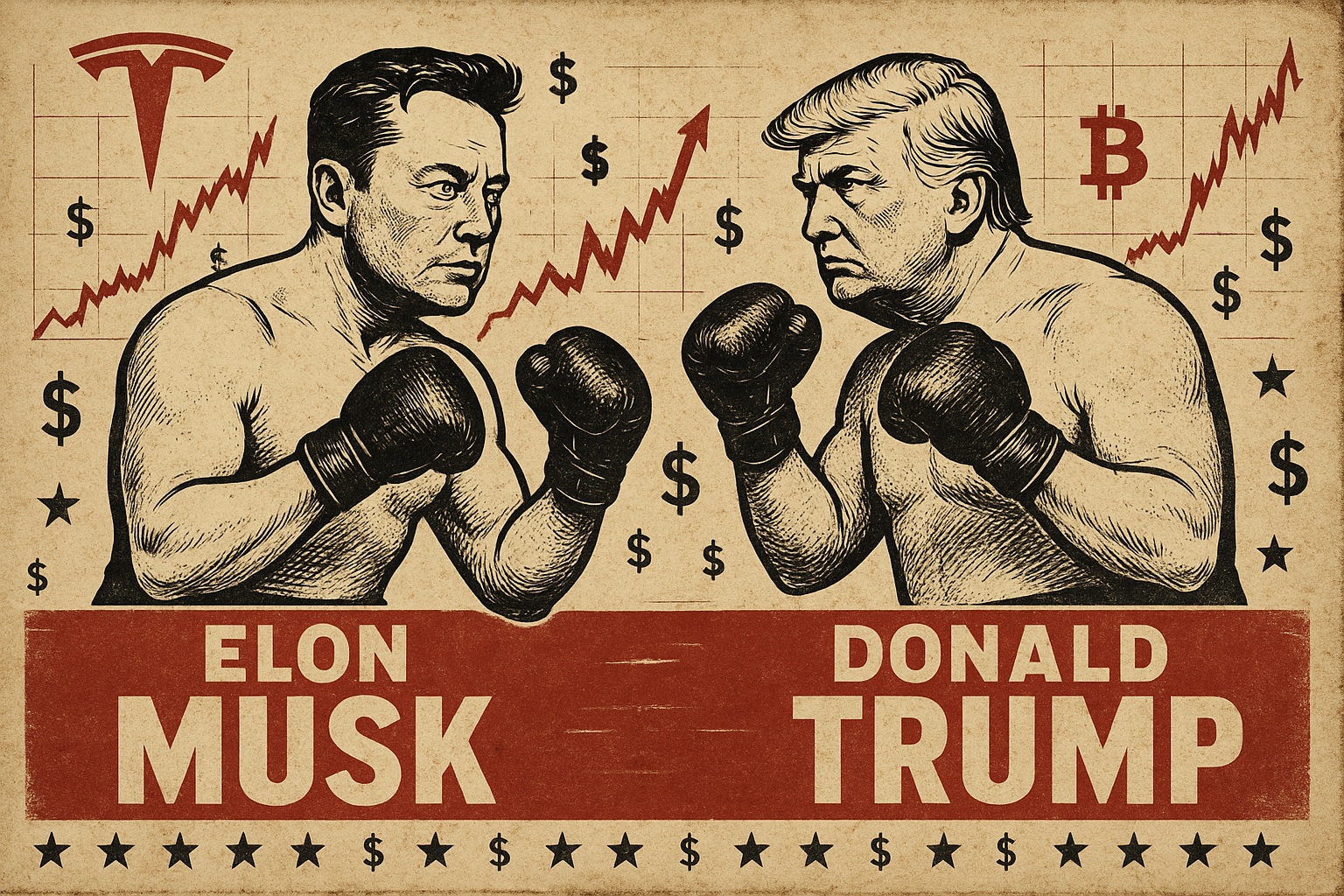The financial world watched in horror as two of the most powerful men in America turned their public feud into a market massacre. In just 24 hours, Tesla lost $150 billion in market value while crypto traders saw $986 million wiped out in liquidations.
This wasn’t just another political spat. This was a perfect storm that showed how personality conflicts can destroy portfolios faster than any economic crisis.
The Day That Shook Wall Street
June 5, 2025 started like any other trading day. By closing bell, it had become one of the most brutal sell-offs in recent memory.
Tesla’s stock crashed 14% in a single session. Bitcoin dropped below $101,000 for the first time in weeks. The crypto market bled red across every major exchange.
Ross Gerber, CEO of Gerber Kawasaki, called it a “disaster of epic proportion” for both Tesla and SpaceX. He wasn’t wrong.
The trigger? Elon Musk’s explosive criticism of Trump’s tax bill, which he called a “disgusting abomination.” Trump fired back by saying he had no plans to speak with Musk and might review his federal contracts.
Tesla’s Historic Collapse
Tesla’s 14% plunge wiped out more wealth in one day than most companies are worth entirely. The stock fell from around $343 to $295, destroying $150 billion in market capitalization.
This wasn’t just a bad day. It was Tesla’s worst single-day performance in years.
The sell-off started in pre-market trading and accelerated throughout the day. Volume spiked as institutional investors dumped shares. Every technical support level crumbled.
But here’s what made it worse: Trump’s tax bill directly targets Tesla’s business model. The legislation eliminates EV tax credits that help consumers afford electric vehicles. For Tesla, this isn’t just political theater – it’s an existential threat to sales.
The company also faces billions in government contracts through SpaceX that could disappear if Trump follows through on his threats.
Crypto’s Billion-Dollar Bloodbath
While Tesla burned, the crypto market faced its own nightmare. Bitcoin dropped more than 4% to $100,500, threatening to break below the psychological $100,000 level.
The CoinDesk 20 Index fell over 5%. Solana and Sui led the destruction with losses exceeding 7% each. Ethereum dropped 6%. Even Dogecoin, Musk’s favorite cryptocurrency, crashed 9%.
But the real carnage happened in the futures markets. Liquidations totaled $986 million across all cryptocurrencies. Bitcoin alone saw $324 million in long positions get destroyed.
These weren’t small retail traders getting wiped out. These were leveraged positions worth millions, disappearing in minutes as stop-losses triggered cascading sell-offs.
The Meme Coin Massacre
The $TRUMP meme coin, directly tied to the former president, lost $100 million in value. It was poetic justice in the worst possible way.
Political tokens have always been volatile, but this showed how quickly speculation can turn into devastation. When your token is named after someone in a public feud, you’re essentially betting on their relationship status.
The irony wasn’t lost on crypto traders. Trump’s own token was tanking during his presidency, creating a feedback loop of negative sentiment.
Traditional Crypto Stocks Get Hammered
The pain spread beyond digital assets. Public companies with crypto exposure felt the heat:
Coinbase (COIN) dropped 4.6% as trading volumes suggested panic selling. MicroStrategy (MSTR), often called a Bitcoin proxy, slid 2.4%.
Crypto mining stocks got crushed even harder. Marathon Digital (MARA), Riot Platforms (RIOT), and Core Scientific (CORZ) all lost around 5%.
These companies depend on crypto prices for profitability. When Bitcoin falls, their business models suffer. When Bitcoin falls because of political uncertainty, investors run for the exits.
Why This Happened So Fast
Modern markets move at lightning speed. Algorithmic trading systems detected the initial selling pressure and amplified it. High-frequency trading robots don’t care about politics – they just follow price momentum.
The correlation between Tesla and Bitcoin also surprised many traders. Historically, these assets move independently. But Musk’s influence on both markets created an unexpected link.
Social media made everything worse. Every tweet, every news headline, every rumor got priced in immediately. The feedback loop between social sentiment and market prices accelerated the crash.
The Recovery Question
Tesla showed signs of life the next day, rising 3.7% to close at $295.14. The stock even gained as much as 6% during intraday trading.
But is this a genuine recovery or just a technical bounce?
The fundamentals haven’t changed. The political feud continues. The tax bill still threatens EV incentives. Government contracts remain at risk.
For crypto, the picture is more mixed. Bitcoin stabilized above $100,000 but remains vulnerable. Liquidations have cleared out some of the leveraged positions, which could reduce selling pressure.
However, the underlying trigger – political uncertainty – hasn’t disappeared.
What Traders Are Doing Now
Smart money is adapting quickly. Options traders are buying Tesla volatility, betting on continued price swings. Some are playing the recovery angle, others are hedging for further drops.
In crypto, dollar-cost averaging strategies are popular. Traders are buying small amounts regularly, hoping to catch the bottom without timing it perfectly.
Risk management has become crucial. Position sizes are smaller. Stop-losses are tighter. Diversification matters more than ever.
The Broader Market Impact
Tesla’s weight in major indexes means its pain spreads everywhere. The S&P 500 and Nasdaq 100 both felt the drag from Tesla’s collapse.
This highlights a growing problem: market concentration. When a few giant companies dominate indexes, their individual problems become everyone’s problems.
The crypto market faces similar issues. Bitcoin’s movements drive everything else. When political events affect Bitcoin, the entire digital asset ecosystem suffers.
Portfolio Implications
This episode teaches important lessons about modern investing:
Concentration risk is real. Having too much exposure to any single stock or crypto can destroy portfolios overnight.
Political risk matters more than ever. When individual relationships can move markets, investors need to factor personality conflicts into their analysis.
Correlation isn’t stable. Assets that normally move independently can suddenly become linked through unexpected channels.
Liquidity is king. In crisis moments, being able to exit positions quickly becomes more valuable than any potential upside.
The New Reality
We’re entering an era where individual personalities drive market movements as much as economic fundamentals. Musk’s tweets move crypto prices. Trump’s statements affect entire sectors.
This creates both opportunities and risks. Savvy traders can profit from these personality-driven swings. But conservative investors face new challenges in building stable portfolios.
The traditional approach of buying and holding diversified assets may not work when political feuds can wipe out billions in hours.
Looking Forward
The Trump-Musk feud isn’t over. Neither man shows signs of backing down. This means more volatility ahead for both Tesla and crypto markets.
Investors need to prepare for continued uncertainty. That means smaller position sizes, better risk management, and constant monitoring of political developments.
The days of ignoring politics while investing are over. In today’s interconnected world, every tweet matters. Every feud has financial consequences.
The question isn’t whether this will happen again. It’s when, and how much you’ll lose if you’re not prepared.



